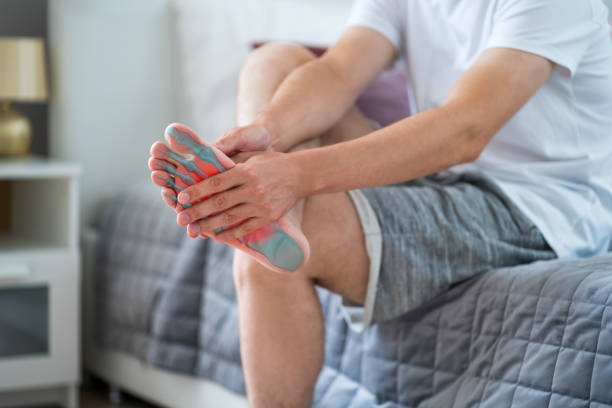Heel to Toe Troubles: Effective Solutions for Heel Pain

Heel pain is a common ailment that affects millions of people worldwide, disrupting daily activities and causing discomfort. From athletes to desk workers, anyone can experience heel pain due to various factors such as overuse, improper footwear, or underlying medical conditions. However, understanding the root causes and adopting effective solutions can significantly alleviate discomfort and improve quality of life. In this article, we’ll delve into the causes of heel pain and explore proven strategies for relief.
Understanding Heel Pain
The heel is a complex structure comprising bone, ligaments, tendons, and connective tissue. When any of these components undergo excessive stress or damage, heel pain can occur. The most prevalent causes of heel pain include:
- Plantar Fasciitis: This condition involves inflammation of the plantar fascia, a thick band of tissue that runs along the bottom of the foot, connecting the heel bone to the toes. Plantar fasciitis commonly results from overuse, improper footwear, or biomechanical issues like flat feet or high arches.
- Achilles Tendinitis: The Achilles tendon connects the calf muscles to the heel bone and facilitates movement such as walking and running. Overuse or sudden increases in physical activity can lead to inflammation and degeneration of this tendon, causing pain in the back of the heel.
- Heel Spurs: Heel spurs are bony outgrowths that develop on the underside of the heel bone. While not always painful themselves, they can irritate surrounding tissues, leading to discomfort, especially during weight-bearing activities.
- Stress Fractures: Repetitive stress or high-impact activities can cause tiny cracks (stress fractures) in the heel bone, resulting in localized pain and tenderness.
Effective Solutions for Heel Pain
Managing heel pain often requires a multifaceted approach addressing both symptom relief and underlying causes. Here are some effective solutions:
- Rest and Ice: Resting the affected foot and applying ice packs can help alleviate pain and reduce inflammation. Elevating the foot can also aid in reducing swelling.
- Proper Footwear: Wearing supportive footwear with cushioned soles and adequate arch support is crucial for relieving heel pain. Avoid high heels and unsupportive shoes, as they can exacerbate symptoms.
- Stretching Exercises: Performing gentle stretching exercises targeting the calf muscles, Achilles tendon, and plantar fascia can improve flexibility and reduce tension in the affected area.
- Orthotic Inserts: Custom or over-the-counter orthotic inserts can provide additional support and alignment, reducing strain on the heel and promoting proper foot mechanics.
- Physical Therapy: Working with a physical therapist can help identify and address biomechanical issues contributing to heel pain. They can prescribe specific exercises and techniques to improve strength, flexibility, and gait mechanics.
- Night Splints: Wearing night splints that keep the foot in a dorsiflexed position can help stretch the plantar fascia and Achilles tendon, reducing morning stiffness and pain.
- Extracorporeal Shock Wave Therapy (ESWT): In cases where conservative treatments fail to provide relief, ESWT may be recommended. This non-invasive procedure uses shock waves to stimulate healing and reduce pain in chronic cases of plantar fasciitis and Achilles tendinitis.
- Corticosteroid Injections: Injections of corticosteroids into the affected area can provide temporary relief from severe heel pain and inflammation. However, they are typically reserved for cases resistant to other treatments due to potential side effects and risks.
Heel pain can significantly impact daily life and physical activity, hindering mobility and diminishing overall quality of life. However, with the right approach and guidance from healthcare professionals, it is often manageable and treatable. By understanding the underlying causes and adopting effective solutions such as rest, proper footwear, stretching, orthotics, and professional interventions when necessary, individuals can find relief and regain mobility.
In cases where heel pain persists despite conservative measures, seeking the expertise of a podiatrist High Wycombe is highly recommended. Podiatrists are healthcare professionals specializing in the diagnosis, treatment, and prevention of foot and ankle disorders, including heel pain. A podiatrist can conduct a comprehensive evaluation to identify the specific cause of the heel pain, taking into account factors such as foot structure, biomechanics, and lifestyle.
Once the underlying cause is determined, the podiatrist Guildford can develop a personalized treatment plan tailored to the individual’s needs. This may include a combination of conservative treatments such as custom orthotic inserts, physical therapy exercises, and footwear modifications, as well as advanced interventions like extracorporeal shock wave therapy (ESWT) or corticosteroid injections when necessary.
Furthermore, podiatrists can offer valuable advice on preventive measures to minimize the risk of future heel pain episodes. This may involve education on proper foot care, shoe selection, and techniques for maintaining foot health, especially for individuals engaged in sports or activities that place repetitive stress on the feet.
Ultimately, with the expertise and guidance of a podiatrist from Midland Podiatry, individuals experiencing heel pain can receive comprehensive care aimed at addressing the root cause of their condition and restoring comfort and confidence in their daily lives. Visit their website at www.midlandpodiatry.com.au and learn more.
By partnering with a podiatrist and adhering to a personalized treatment plan, individuals can overcome heel pain and step forward with improved mobility and well-being.
